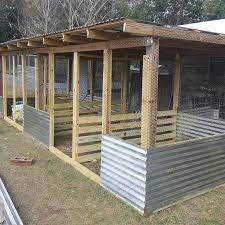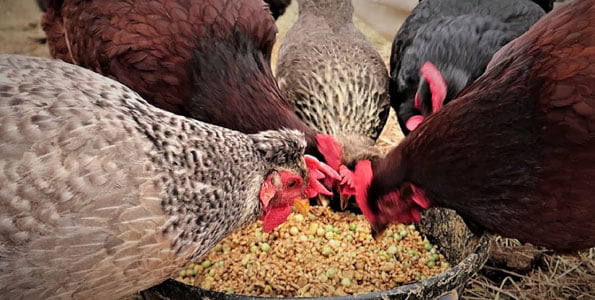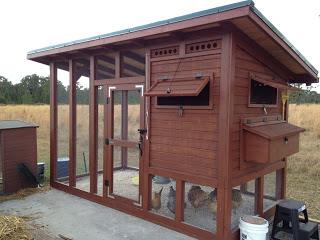BEST CHICKEN HOUSES
The construction of good chicken coops is one of the most fundamental aspects of good chicken farming, whether natural or improved. However, not every construction style is suitable, so the construction must take into account the actual needs so that the farming can produce the best results expected by the farmer.
The important things in building a chicken coop are;
1. Keep it well ventilated at all times.
2. Always keep it dry.
3. There should be enough space.
4. It should be affordable but durable.
5. Prevent the entry of animals and insects harmful to chickens.
6. Have space for food and water containers.
7. Protect it from the wind during cold weather.
Air is essential for every living thing, so a chicken coop must allow fresh air in, exhaust stale air out, and allow sufficient light in.
1. In short, the windows of the pavilion must be large and sufficient to allow fresh air to enter and exhaust the polluted air.
2. It is best to have these windows about one (1) meter above the ground so that air can pass over the chickens’ heads.
3. Fresh air is not wind, so try to prevent strong winds from entering the chicken coop or else the chickens will get sick with flu and pneumonia and the chicks may die from cold.
4. Build your coop to protect it from the wind and plant trees around the chicken coop to reduce wind speed and provide shade from the hot sun and heat.
DRYNESS AND INDOOR CLEANLINESS:
Since chickens are not aquatic birds like ducks, it is wise to ensure that their living space is free from moisture.
§ The chicken coop should be built on an elevated place to prevent rainwater from entering.
§ Build a roost for the chickens by placing one-meter-high poles and laying wood on top of them so that they can roost there at night, rather than laying them on the ground or floor.
§ The dryness of the coop is very important, especially for chicks and laying hens. In a damp coop, eggs become very dirty and sometimes rot easily, and your efforts will be in vain.
§ The floor of the shed is preferably made of concrete, but due to lack of funds, the floor can be made of slats (raised sheds) or hard earth and/or sand which will be covered with rice and wood waste residues.
§ To avoid humidity, it is best to build the shed in an elevated area with adequate ventilation.
ROOF OF THE BANDA:
The roof of the pavilion should be solid to prevent rainwater from entering, especially during the rainy season. The floor of the pavilion should be higher than the outside level. The roof can be covered with scraps of tin, boxes, and if that fails, use grass suitable for thatching houses in the area.
The chicken coop should not have so many poles or boards inside that it would make it difficult for the chicken keeper to do his job. This would cause him to waste a lot of time walking around the poles, especially when collecting eggs or cleaning.
EQUIPMENT:
When you want to build a chicken coop, first of all prepare the necessary materials. Things like trees or grass, nets or poles, nails or ropes are important to prepare in advance. Second, you must have a complete plan/map of the coop. On average, each chicken needs a space of 0.11 to 0.22 square meters (1 to 2 square feet) depending on the age of the chicken.
SIMPLE CONSTRUCTION:
Chickens must eventually pay for the construction of the sheds and feed. If the costs are too high, you may make the breeding activity unprofitable at all, which will make the breeder see that breeding has no meaning for him. But if you build your shed using readily available materials, you will increase your profits even more because you have reduced the operating costs of the project.
DIMENSIONS:
The chicken coop should be 15 to 22 meters in area, that is, 3 to 4.5 meters wide by 5 meters long. This coop can house 100 large chickens at a time.
CONCLUSION;
· The construction of sheds is emphasized in improving indigenous chicken farming in order to;· Increase production and reduce chick mortality due to various threats such as hawks, hawks, cats, dogs and theft of chickens that roam freely.· It is also expected that chickens confined in sheds and fed mixed food will increase production significantly.
a. Chickens start laying at 22-32 weeks of age after birth depending on breed, health and nutrition. Usually local/native chickens will lay later than modern ones. Females reach their peak laying rate at 40-50 weeks of age and after that age laying starts to decline gradually. When this situation starts to occur, farmers are advised to sell or slaughter chickens that have reached that age.
b. Laying hens must receive a diet with sufficient calcium. This diet can be improved by adding crushed eggshells and snail shells.
c. Provide them with nests to lay in their coops, this way it is easier to get eggs and the eggs are also clean. To teach chickens to lay in nests, you can put a few eggs in the nest or stones that look like eggs. When the chickens start laying, they stop laying, due to picking several times a day you can avoid the chicken wanting to lay. It is advisable to immediately isolate the hens that start laying by placing them in a small, quiet coop so that they can stay alone in a place without a nest for a few days.
d. The ideal temperature for laying hens is between 18ºC -29ºC.
Egg sales:
1. Make sure you do your research before you start breeding.
2. Sell eggs based on standards such as color, size, and texture.
3. Sell clean eggs by making sure you arrange clean eggs in a tray and clean the dirty ones by wiping them with a cotton ball or cloth soaked in soap-free water (the cloth should not be soaked in water). These eggs should be cleaned before being sold.
4. Reduce egg breakage and contamination. This is only possible when you ensure that you make nests and collect them regularly. It is recommended that you collect eggs three times a day. In the morning during feeding, at noon and in the evening. Egg breakage increases losses to the project and contaminates the hatching trays.
Incubation.
Chicken eggs take 21 days to hatch, while duck eggs take 28 days to hatch.
Natural incubation and hatching of chicks :
Eggs for incubation must be fresh ;
1) The age of the eggs after laying should not be more than ten (10) days and they should be stored in a cool place not exceeding 20ºC. If the temperature is higher than 20ºC, then the eggs that will not hatch should not be stored for more than five (5) days.
2) To obtain good results, the eggs to be incubated (selected eggs) should be of normal shape and average size for the type of chicken involved.
3) The shell of hatching eggs should not have scratches or cracks, as if there are cracks, the egg loses moisture, which if reduced can cause the egg to die or can introduce pathogens such as fungi and bacteria that lead to the release of unhealthy or dead chicks.
4) Store the hatching eggs in dry boxes in a hole in the ground in the coolest part of the room.
5) Before the eggs are fertilized, examine the eggs that have sperm and those that do not. The eggs of hens fertilized by roosters develop a network of blood vessels very early on which can be seen using a bright light.
6) Before the eggs are fertilized, examine the eggs that have sperm and those that do not. The eggs of hens fertilized by roosters develop a network of blood vessels very early on which can be seen using a bright light.
7) After seven to ten days of incubation, eggs can be examined. Unfertilized eggs and eggs with dead embryos can be identified within seven days of starting to hatch.
8) When examined using a microscope, fertilized eggs have visible blood vessels, and a dark spot that is the center of life.
9) If the cell is dead, it appears as a circular object resembling a ring around the living cell.
10) Unfertilized eggs have a large amount of air space and a life-giving substance that appears as a black substance inside the egg. Unfertilized eggs and those with fertilized eggs must be separated and removed so that they do not rot in the nest, crack and destroy the good eggs that are in the incubator.
1) A hen that is laying eggs should be separated from the flock so that it is not disturbed by other hens,
2) Provide the chicken with a nest that provides it with access to clean water and food nearby.
3) The nest or basket must be large enough to give the hen room to incubate all the eggs.
4) Apply fresh, dry mulch sprinkled with a little sand to prevent pests.
5) If the number of chicks that are hatched is few, the best way to incubate eggs is to use a hen rather than a machine that does not hatch chicks because a hen has a greater ability to hatch chicks by 80-100 percent compared to a machine that only hatches 60-80 percent of the time. Once the chicks are hatched, they can be raised using the mother if there are few. But the chicks can be raised using a special chick-rearing device
………………………………………………………………………………………………………………………………….





